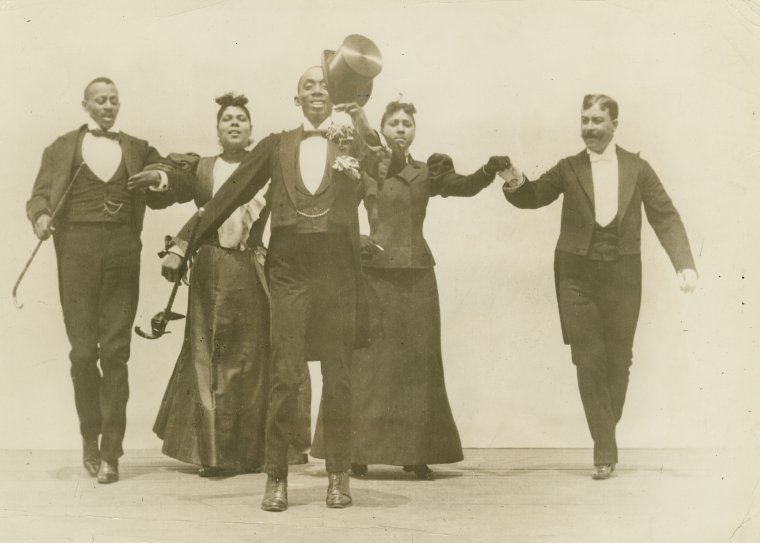
Editor's Note: The historical photos in this story feature a variety of dances inspired by music from the 20th century.
I must have been 7 or 8 when I first heard Scott Joplin's "The Entertainer" in the movie The Sting. This would have been at the historic Castro Theater in San Francisco, where my mom used to take us for double matinees of old movies on weekday afternoons. We called this "homeschooling."
Like pretty much every other piano student in America, I set about learning how to play "The Entertainer." Everyone was playing it. The sound of that piece, performed hesitantly and unevenly, with stumbles over the tricky parts, is burned into my memory. My friend Helga can still sing the tune with the fingering her piano teacher assigned: 1-2, 1-5, 1-5, 1-5, 2-3-4-5-2-3-4-1-3-2. And the tinkling version of the song from the ice cream truck in my neighborhood further drilled the song into my head, signaling the sound of summer.
Joplin wrote "The Entertainer" in 1902, at the dawn of a new century. That year, President Theodore Roosevelt rode through the streets of Hartford, Conn., in an electric automobile, the first movie theater opened in Los Angeles, and J.C. Penney launched his first store in Kemmerer, Wyo. Writers John Steinbeck and Arna Bontemps, composer Richard Rogers, and the photographer Ansel Adams were all born in 1902, destined to define a new artistic era.
Leaving his own indelible mark on the 20th century, Joplin was an innovator whose deceptive, irregular rhythms and nuanced harmonic language helped define the trajectory of American music during a time of rapid change and flux. His short life (he died before age 50 in 1917) is almost a case study in the transformations of his time. He was born in northeast Texas just four years after Lincoln issued the Emancipation Proclamation, one of the first Black Americans born into the promise of freedom. A natural-born musician, Joplin absorbed a wide mix of influences, from the plantation melodies his parents played on the violin and banjo to the classical training he received from a generous local piano teacher. By the time Joplin was in his teens, in the 1880s, he was making a living as an itinerant musician, shaping a brand new American sound.
Joplin became the "King of Ragtime," a pioneer of a genre that permanently altered American culture. It exploded onto the scene in 1893, thanks in part to the World's Columbian Exposition, an expansive fair in Chicago visited by some 27 million people. While the fair itself was segregated, the saloons, cafés and brothels surrounding the fairgrounds resonated with the melodies of traveling ragtime musicians, including Joplin, who was there with his own band. The St. Louis Dispatch described this new national craze as "a veritable call of the wild, which mightily stirred the pulses of city-bred people."
Ragtime introduced mainstream America to the simple but radical trick of syncopation in rhythm – that displacement of the beat which causes a propulsion, a swinging of the hips, a feeling that anything might happen. Joplin's innovations in ragtime laid the foundation for much of 20th century American music: first blues, jazz and swing, then R&B and rock-and-roll. Nothing would ever be the same again.
And now, as I'm revisiting Joplin's legacy with a new album of his piano music – yes, including that famous piece I learned so long ago – I see him standing at a crossroads. He was a product of his time, with ambitions that exceeded it. His music is a total embrace of everything he was made of, and a vision of making something new. He spent his life bumping up against color lines while his work crossed over them. He invented and innovated because he had to. This is a central motif in American music, a truth I take for granted as my lineage and my legacy. And in the end, I choose to see it as something unintentionally liberating and transformative. This is how hybridization happens, how adaptive novelty fuels change, how new languages are invented.
(A portion of this essay originally appeared in the booklet notes of Lara Downes' album, Reflections: Scott Joplin Reconsidered.)
Listening to "The Entertainer"
Over the years, musicians from many diverse backgrounds have put their own stamp on "The Entertainer." I've collected some of my favorites – and a few crazy versions – in this playlist. There's old-school violin elegance from Itzhak Perlman, piano jazz virtuosity from Marcus Roberts and a lilting folk treatment from guitarist Dave Van Ronk. Stepping further afield, try the trippy rendition by dub/reggae artists Sly & Robbie, or the nostalgic, bluegrass-tinged harmonica from the legendary Larry Adler.
And me? Last year, when I picked up the sheet music to start planning my Joplin album, I saw something I hadn't noticed before. Joplin dedicated "The Entertainer" to "James Brown and his Mandolin Club." So I reimagined this timeless tune as a duet with mandolinist Joe Brent, bringing Joplin's vision full circle to be reflected through the lens of our own time.
9(MDEyMDcxNjYwMDEzNzc2MTQzNDNiY2I3ZA004))








